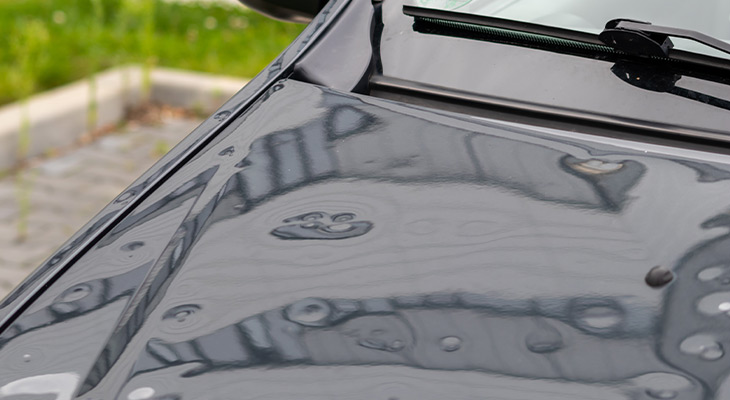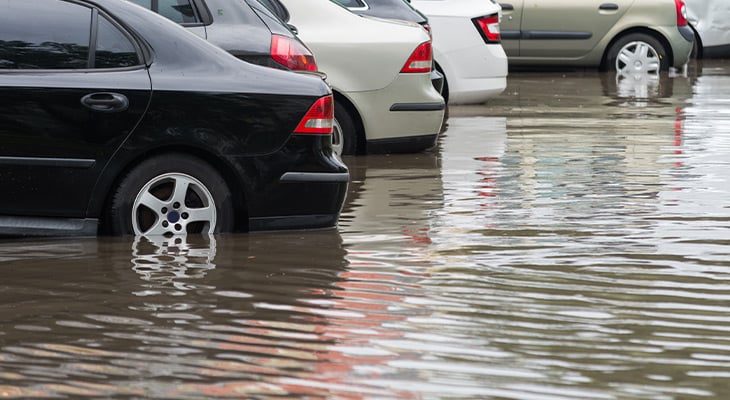Comprehensive Insurance: How Does it Work, and What’s Covered?
At Compare.com, it’s our mission to find simple ways to help our customers save money on the things they need. While we partner with some of the companies and brands we talk about in our articles, all of our content is written and reviewed by our independent editorial team and never influenced by our partnerships. Learn about how we make money, review our editorial standards, and reference our data methodology to learn more about why you can trust Compare.com.
Comprehensive car insurance pays for damages to your car caused by something other than a collision. This coverage would kick in if your vehicle gets vandalized, hit by a falling tree branch, or damaged by a natural disaster like a flood or hurricane.
When purchased together, a collision and comprehensive policy are often called “full-coverage” auto insurance. Full coverage is more expensive than a liability-only auto policy, but you can reduce your costs by comparing quotes from different insurers.
Get Cheaper Coverage in Minutes
What Does Comprehensive Car Insurance Cover?
Comprehensive car insurance pays to repair your vehicle if it’s damaged by a non-collision accident. It also covers damages caused by theft, vandalism, and natural disasters.
The following table outlines what comprehensive insurance covers and what’s excluded from coverage.
| Comprehensive Insurance Covers | Comprehensive Insurance Doesn’t Cover |
|---|---|
| Natural disasters, like earthquakes, hurricanes, and tornadoes | A collision with another car or object |
| Fire damage | Damages caused by potholes |
| Vandalism and theft | Medical costs for you or another passenger |
| Damage from falling objects | Personal belongings inside your vehicle |
| Broken windshield | Typical wear and tear |
Comprehensive insurance pays for damages caused by accidents with animals, falling trees, or a fire, but it won’t pay for damages caused by a collision with another car or typical wear and tear. Later, we’ll break down the difference between comprehensive and collision.
How Does Comprehensive Car Insurance Work?
If your vehicle is damaged in a non-collision incident and you have comprehensive coverage, you’ll start by filing a claim with your insurance company. Most insurers allow you to file a claim online or over the phone, and they may require additional documentation, like photos of the damage.
Once your claim is approved, you’ll pay your car insurance deductible — the portion you’re responsible for paying before your insurance coverage kicks in (we’ll cover this in more detail later). From there, your insurance company will pay the remaining costs.
Keep in mind that filing a comprehensive claim may cause your insurance rates to increase depending on the type of incident — but not by as much as an at-fault accident.
Comprehensive vs. Collision Insurance
Comprehensive and collision insurance are typically purchased together since they both provide essential coverage for drivers. While they both pay for physical damage to your car, each covers different incidents.
Comprehensive coverage pays for damages that aren’t a result of a collision — like theft or vandalism. Collision insurance pays for damages resulting from car accidents (with a vehicle or object), car rollovers, and even hitting potholes.
Both comprehensive and collision insurance are optional, and your state won’t require you to purchase them. But most drivers do, thanks to the protections they provide. Many lenders also require you to purchase collision and comprehensive coverage if you finance your vehicle.
On average, comprehensive insurance costs significantly less than collision insurance: $116 less, based on our analysis. The average cost of collision insurance is $290 per year, according to data from the Insurance Information Institute (Triple-I).
Still, the exact cost of comprehensive insurance can vary depending on your driving history and other factors. We’ll discuss this in more detail below.
How Much Does Comprehensive Insurance Cost?
The national average for comprehensive coverage is $174, according to the National Association for Insurance Commissioners (NAIC). It’s less expensive than other types of coverage. Your insurance premiums are determined by a variety of factors, including the type of car you drive, your age, and how often you use the vehicle.
Car insurance premiums are also heavily influenced by where you live. Drivers living in densely populated urban areas typically pay more than those in rural areas. It’s important to know how the state you live in can affect what you pay for auto insurance.
Let’s look at the average premium by state.
The cost of comprehensive coverage by state
The exact cost of comprehensive coverage can vary substantially depending on where you live. The following table outlines the average costs by state, according to the NAIC.
| State | Average Comprehensive Premium |
|---|---|
| Alabama | $186 |
| Alaska | $156 |
| Arizona | $209 |
| Arkansas | $245 |
| California | $97 |
| Colorado | $312 |
| Connecticut | $139 |
| Delaware | $140 |
| Florida | $224 |
| Georgia | $156 |
| Hawaii | $183 |
| Idaho | $107 |
| Illinois | $145 |
| Indiana | $147 |
| Iowa | $140 |
| Kansas | $231 |
| Kentucky | $283 |
| Louisiana | $169 |
| Maine | $254 |
| Maryland | $123 |
| Massachusetts | $171 |
| Michigan | $150 |
| Minnesota | $168 |
| Mississippi | $217 |
| Missouri | $246 |
| Montana | $223 |
| Nebraska | $310 |
| Nevada | $269 |
| New Hampshire | $116 |
| New Jersey | $122 |
| New Mexico | $132 |
| New York | $220 |
| North Carolina | $177 |
| North Dakota | $155 |
| Ohio | $260 |
| Oklahoma | $134 |
| Oregon | $268 |
| Pennsylvania | $109 |
| Rhode Island | $174 |
| South Carolina | $149 |
| South Dakota | $217 |
| Tennessee | $353 |
| Texas | $173 |
| Utah | $279 |
| Vermont | $126 |
| Virginia | $155 |
| Washington | $149 |
| Washington, D.C. | $121 |
| West Virginia | $227 |
| Wisconsin | $170 |
| Wyoming | $352 |
| National average | $174 |
Comprehensive coverage is the most expensive in Colorado, Wyoming, and Tennessee. Drivers in these states pay monthly premiums of $138–$174 more than the national average. Meanwhile, drivers in California, Idaho, and Pennsylvania pay the least. Premiums in these states are $65–$77 cheaper than the national average.
Higher reports of extreme weather conditions may be why these states are more expensive.
Find the Coverage for You
What’s a Comprehensive Deductible?
A comprehensive deductible is the amount you pay out of pocket for damages when filing a comprehensive insurance claim. For example, let’s say you file a claim for $5,000 in damages, and your deductible is $500.
Once the claim is approved, you’ll pay $500, and your insurance company will pay the remaining $4,500. But let’s say your repairs only cost $250. In that case, you’ll pay for the repairs yourself since the damages don’t exceed the deductible.
Most insurance companies will pay your vehicle’s actual cash value (ACV) if it’s totaled, so it’s important to consider that when choosing your deductible. A higher deductible will lead to lower monthly premiums, but this also means you’ll pay more money out of pocket when you file a claim.
Who Needs a Comprehensive Coverage Policy?
Comprehensive insurance is an optional coverage that’s not required by law, but it’s often still a good idea to purchase it. In particular, you should consider comprehensive insurance if the following factors apply:
- Your car is leased or financed: Some lenders will require you to purchase comprehensive coverage if you lease your vehicle or have a car loan. If you own your vehicle, you can decide whether or not you need this coverage.
- You have a high-value car: If you have a high-value car that would be expensive to replace, buying comprehensive coverage is a good idea.
- You live in an area prone to natural disasters: If you live in a state prone to natural disasters, you should probably buy comprehensive insurance.
Find the Best Comprehensive Rates in Minutes
Is Comprehensive Coverage Worth It?
Whether comprehensive insurance is worth it depends on your circumstances. You should always weigh the potential cost of repairs against what you’ll pay in premiums.
For example, you may not need comprehensive coverage if you have an older vehicle you’ve paid off. But if you drive an expensive vehicle and feel like you wouldn’t be able to pay for car repairs if it gets damaged, purchasing comprehensive coverage is probably worth it.
Here are some advantages and disadvantages of buying comprehensive coverage.
Pros:
- Covers damage caused by unexpected events
- Less expensive than collision insurance
- Protects high-value vehicles
Cons:
- Causes car insurance costs to go up
- May be unnecessary for older vehicles
- Some items are excluded from coverage
Comprehensive Auto Insurance FAQs
If you’re still on the fence about whether you need comprehensive coverage, the following frequently asked questions may help.
Do you need comprehensive coverage car insurance?
It depends. If you live in an area that experiences a lot of natural disasters or own a high-value vehicle, you’re at a higher risk for damages, and you should consider getting comprehensive auto insurance coverage for the added protection. But if you have an older vehicle that’s paid off, you may not need this coverage if you can afford to replace it.
Is it better to have collision or comprehensive?
Comprehensive and collision coverage are equally important. Collision insurance protects you from accidents with other vehicles and objects, while comprehensive coverage protects you from non-collision incidents. Both coverages can be beneficial if you can’t afford to repair or replace your vehicle after an accident.
Why is comprehensive insurance so expensive?
Comprehensive insurance costs differ based on various factors, such as where you live. The state you live in might have higher insurance rates for several reasons, including high claims rates, theft, or even natural disasters. If this is the case for your state, it’s even more important for you to purchase comprehensive coverage.
What’s the difference between liability and comprehensive insurance?
Liability insurance pays for damage to other drivers and their medical expenses resulting from an accident you caused. Most states require drivers to have specific amounts of liability insurance. On the other hand, comprehensive insurance is an optional policy that pays for damages caused by non-collision incidents, like a tree falling on your car.
Is it worth having comprehensive insurance on an old car?
It depends. Comprehensive insurance may not be worth it for older vehicles, particularly if your car is over 10 years old. That’s because your insurance company will only reimburse you for the actual cash value of your car. Drivers of older cars may want to consider dropping comprehensive coverage to save money on their insurance.
Sources
- Insurance Information Institute, “What is covered by collision and comprehensive auto insurance?,” Accessed January 8, 2024.
- Insurance Information Institute, “Understanding your insurance deductible,” Accessed January 8, 2024.
- Insurance Information Institute, “What determines the price of an auto insurance policy?,” Accessed January 8, 2024.
- National Association of Insurance Commissioners, “2019/2020 Auto Insurance Database Report,” Accessed January 8, 2024.
Compare Car Insurance Quotes
About Compare.com
Compare.com’s #1 goal is to save you money. We publish resources that are based on hard-hitting data and years of industry experience to help you make more informed decisions with your wallet.
- All of Compare.com’s content is written and reviewed for accuracy by a team of experienced writers and editors who are experts on the topics they cover.
- None of Compare.com’s content is ever influenced by the companies and brands we partner with.
- Compare.com’s editorial team operates independently of any of the company’s partnership or business development interests. We publish unbiased information strictly for the benefit of our readers.
- All of the content you see on Compare.com is based on comprehensive analysis and all data is gathered and vetted from trustworthy sources.
Learn more about us, our team, and what makes us tick.








